Pumpkin and squash production
Learn best management practices for growing pumpkins and squash.
Introduction
Pumpkin and squash are important sources of income for many growers in Ontario. Halloween now has a huge public following and is second only to Christmas in decorative spending.
Consequently pumpkin production has increased significantly. There is certainly a great deal of eye appeal for both pumpkin and squash products (Figure 1)
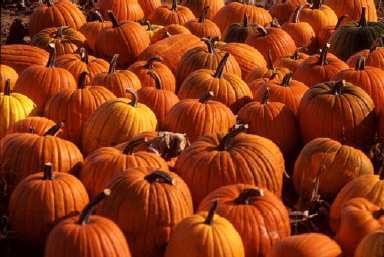
Climatic requirements
All cucurbits are warm-season crops. They grow best during hot weather and cannot tolerate frost. Seeds will germinate at 15°C (60°F), but germinate best at 29-32°C (85°F-90°F). Pumpkins and squashes grow best at temperatures of 23-29°C (75°F-85°F) day and 15°C-21°C (60°-70°F) night. Growth virtually stops at temperatures below 10°C (50°F) and the plants may be severely injured and maturity delayed by temperatures below 5°C. (40°F) for several days.
Plants are usually killed by one hour or more of frost (temperature below 0°C, 32°F). Therefore, plant cucurbits in the field when soil temperatures are high enough for good germination and all chance of frost has passed. For early summer squash production, plastic mulch and/or row covers will raise soil temperatures and provide some frost protection.
Low temperatures also have an adverse effect on flowering and fruit set. Cucurbits are monoecious plants - that is, each plant produces both male and female flowers. Normally, several male flowers form before female flowers develop. During periods of cool temperatures (below 22°C, 70°F) most pumpkin and squash cultivars respond by producing primarily male flowers. Male flowers do not form fruit. By contrast some cultivars of summer squash appear to form mostly female flowers in response to cool temperatures. Without male flowers to provide pollen, however, the female flowers do not form fruit. (Figures 2, 3 and 4).
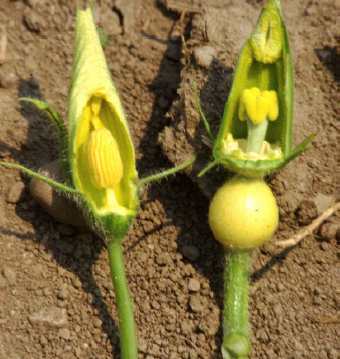
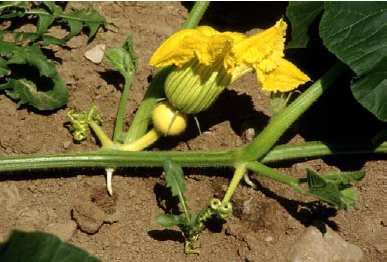
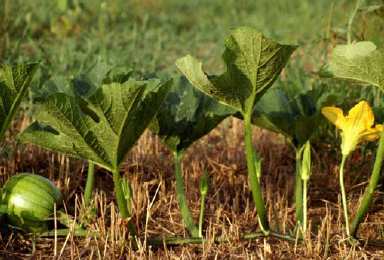
Pumpkins and squashes are relatively deeply rooted (1.2-1.8 m; 4-6 ft) and can tolerate dry conditions fairly well. However, extended dry periods will result in poor fruit set and/or poor fruit development and size. Plants tolerate wet conditions fairly well, but foliar diseases and fruit rots increase. Plants also form adventitious roots at the notes (Figure 3) and help with water uptake.
Summer squashes are especially susceptible to drought because the fruit develop and are harvested within a few days of pollination. Lack of sufficient moisture often results in poor or irregular fruit development.
Pumpkins and squashes are usually grown without irrigation, but is a great benefit if available. If irrigation is available, apply 2.5-3.75 cm (1-1½ in.) of water per week during flowering and fruit development. Summer squashes usually benefit from regular irrigation throughout production.
Soil and fertility
Pumpkins and squashes grow well on most well-drained soils. Sandy loams are ideal. They also grow well on clay soils, but harvest is difficult when soils are wet and the fruit often become dirty and difficult to clean. Avoid production on low-lying or muck fields where plants are subject to late spring or early fall frosts.
Cucurbits are good rotational crops with other vegetables. Because they are usually grown for fall harvest, they can be planted in late May or early June, and thus fit well into a planting schedule.
Presently, OMAFRA recommendations suggest up to 110 kg of nitrogen/ha for pumpkin and squash whereby 65 kg of N is applied preplant broadcast, with the remainder applied as a side-dress just prior to vine-run.
Planting and spacing
Seed pumpkins and squashes with corn planters, using plates designed specifically for these crops, or with vacuum seeders. Plant seed 2.5–3.75 cm (1–1½ in.) deep in moist soil.
Traditionally, medium-vined squashes and pumpkins are planted in rows 2–2.5 m (6–8 ft) apart, with plants spaced 0.5–0.6 m (1½–2 ft) apart in rows. However, many growers use a 2 m x 2 m (6 ft x 6 ft) spacing to allow for cross-cultivation. Where late season application of pesticides is anticipated, leave spray and harvest aisles.
For larger varieties with fruit-size expectations of 9 kg (20 lbs) or more, plants require a minimum of 3–3.6 m2 (35–40 ft2) each. Over-crowding stresses plants, creating smaller fruit size. One hundred square feet per plant may seem excessive, however, evidence suggests this is preferable.
In addition to fruit set problems, close spacing causes vine growth to become 'airborne' — meaning that vines that would normally root in the soil at the nodes will not be able to do so as the vine growth is not situated along the soil surface were it belongs.
The amount of seed needed per acre varies with type, cultivar and spacing. Large seeded cultivars (most pumpkins and winter squashes) require 0.5–1 kg (1–2 lb) of seed/acre. Note: For larger sized varieties, there are approximately 6,600 seeds/kg (3000 seeds/lb).
Weed control
Control weeds through frequent, shallow cultivation. Although pumpkins and squash are deep-rooted, most roots are near the surface. Deep cultivation is very harmful, destroying many of the fine roots near the soil surface. Hand-weeding and hoeing is usually required. As the plants cover the ground, they shade out many weeds.
Herbicides also help control weeds. However, there are currently limited choices available for pumpkins and squash. For more details, see OMAFRA Publication 363, Vegetable Production Recommendations, or Publication 75, Guide to Weed Control.
Bees and pollination
Bees are an essential part of the production of all vine crops. Wild bees and other insects are normally sufficient to pollinate small fields. However, where fields exceed 1–2 acres, bring in beehives for pollination. One hive is needed for every 2–3 acres of pumpkins and squash.
Place hives in protected areas at edges of fields. Since bees normally forage as close to the hive as possible, usually within ¼ mile, place hives around the field to obtain more complete pollination of large fields.
Blossom density for squashes and pumpkins is low. Therefore these crops are not very attractive to bees. In addition, each cucurbit flower has to be visited at least 15 times for complete pollination. Incomplete pollination results in small and misshapen fruit. To improve the success of pollination, place bees in fields 3–5 days after the first blossoms appear — at that time about 10–15% of the plants should have open female flowers. Because they are unaccustomed to the area, the bees will forage close to the hive and will not stray into more attractive crops further away.
Growth and development
How many fruit (pumpkins) can be expected from a plant?
Although pumpkin plants produce a profusion of flowers throughout the life of the plant, and starting very early in the plants development, only 1 or 2 pumpkins per plant develop to any size. This varies depending on the type and variety of pumpkin grown.
The bush or semi-bush pumpkin (e.g. Spirit) yields more than the traditional type vines, such as Connecticut Field or Howden. However, as a rule of thumb, and as a general guide to predicting yields, expect only about 1 to 1.5 pumpkins per vine.
Thus, if pumpkins were seeded and thinned to a population of 2,900 plants to the acre (5 ft row centres, 3 ft within the row), then yields should range up to about 4000 pumpkins per acre; an alternate spacing of 8 ft by 2 ft will give about the same yield. The old traditional spacing on a 6 ft square (1,210 plants/ac) would only yield about 1,800 fruit.
Miniature pumpkins, such as 'Baby Boo', 'Sweetie Pie', 'Jack-Be-Little' and 'Munchkin', can easily yield 12–15 fruit per plant.
Never predict yields by the numbers of blossoms present, but only by the fruit visible!
If there are so many blossoms on any one vine throughout the season, why are there not more fruit per plant?
All pumpkins and squash produce both male and female flowers separately on the same plant (monoecious sex expression). These flowers originate from the axils of the nodes. First, the male flowers form and bloom, allowing pollen to be available as soon as the first female blossom appears.
The order and numbers in which these flowers appear vary somewhat as to the time of year, the stage of plant development and the number of fruit already pollinated and beginning to size. Developing fruit temporarily reduces the occurrence of female blossoms further down the vine.
Pumpkins and squash are relatively insensitive to photoperiod (length of day) during the summer season.
Female blossoms are short-lived. Female blossoms of pumpkins and squash open first thing in the morning and close a few hours later (24 hours at the most), never to re-open again. If these blossoms are not pollinated they abort and fall off the plant. Generally, the female blossom is open from about 10:00 a.m. to about 3:00 p.m.
Male flowers occur on the vine first. There are typically 10 male blossoms for every female flower. Bees do not prefer one type (male or female) over another, so make sure there are sufficient pollinators to do the job. As well, the proportion of male blossoms usually increases when plants are under stress.
The likelihood of a flower being pollinated depends upon the number of bees present and the number of visits to that flower. If the weather is poor (cold or wet) then there is almost no chance that flowers will be satisfactorily pollinated.
How do these vines grow and where do the flowers occur on the plant?
Pumpkin plant growth is either: a) vining (trailing) or b) semi-erect (bush-like). Bush varieties have shorter internodes (distance between leaves), and lack tendrils. The trailing varieties may have between 3–8 lateral branches each arising from a separate node (point of leaf attachment). Vine growth on the trailing types can be very vigourous with stem lengths totally over 140 ft in some instances, and with up to about 450 leaves in a 4 month growing season!
The yellow flowers occur singly in the axils of the leaves. In trailing varieties, the staminate (male) flowers occur near the center of the vine on long, slender stems; the pistillate (female) flowers occur on short, ridged stems, further 'down' the vine than the male flowers. In bushy types, the pistillate flowers occur near the base of the plant.
How can the size of pumpkins be improved?
Water, temperature, insects and disease, pollination, fertility, soil type, plant population, variety (genetics), weeds all influence the size of crop.
How important is it to keep the vine growing late into the season?
For fruit to grow it must continue to receive nourishment from the mother plant. If the vine dies prematurely, from powdery mildew or an early frost, for example, then any further growth of that fruit will be halted.
However, if the fruit is already physiologically mature it will continue to ripen by turning orange but without increasing in size. 'Mature' green fruit (showing no colour change), that are not physiologically mature, will not turn orange.
Will earlier seeding or using transplants increase yield?
Generally, no. Usually there are only 1–2 pumpkins per plant. As fruit begin to develop, there is a tendency for less female flowers to be produced by the plant. If you seed during the last week of May and up to the 2nd week in June, fruit usually grows to its full size, e.g. 15–20 lbs for varieties such as 'Connecticut Field' and 'Howden'.
Pumpkins are a sub-tropical crop and respond to a longer growing season. However, since the market for this crop is so late, there is little need to hasten its planting.
In fact, in southwestern Ontario, pumpkins usually ripen so early that it often causes concern as to the shelf life of these fruit. Therefore, waiting until all risk of frost is past and soil temperatures have warmed up allows for maximum plant stands. This should also allow the necessary 'window' for the seeding to take place in a moist soil.
In addition, later plantings tend to miss the first generation of seed corn maggots and germinate before the 2nd generation arrives. However, where heavy applications of manure have been applied previously, there is a good chance that various maggots may cause seedling injury, as manure attracts these egg-laying insects.
What can be done to increase the length of the handle (stem or peduncle), and to make the fruit a brighter orange?
Nothing, other than choosing a variety that exhibits those characteristics. These factors are predetermined genetically and nothing in the line of fertilizers or cultural practices will change this. This is also the case when it comes to the degree of ribbing — some cultivars are mostly smooth while others are deeply ribbed. Chose your varieties based on general market demand and individual customer preferences.
What happens to the appearance of a variety if it is cross-pollinated with another variety grown nearby in the same field?
Nothing. Varieties grown in close proximity to one another of the same species (Cucurbita pepo in this case) are not influenced in any way by the pollen it receives during that growing season. However, if seed is collected from fruit for the purposes of growing out the following year, then there is a possibility that the plants will not be true to type — particularly if it was a hybrid to begin with.
Varieties such as 'Big Moon', 'Atlantic Giant' and 'Big Max' belong to a different species (Cucurbita maxima). Nonetheless, both C.pepo and C. maxima can be planted in the same field — even for the purpose of seed production! Different varieties within the species C. pepo do not cross in mixed field plantings.
C. pepo and C. moschata cross readily without having any immediate effect on the quality of fruit. The progeny produce viable seeds, but likely result in an off-type. Therefore, isolate these 2 species for seed production purposes.
Pumpkin and squash classification
The genus cucurbita (gourd family) falls into 4 major categories (species) comprising the majority of pumpkins and squashes. It is important to know where individual varieties belong for cross-pollination. For more practical reasons, a pumpkin is carved, a squash is cooked, and a gourd is to look at.
- Cucurbita pepo can be subdivided into two groups:
- Cucurbita pepo var. pepo (true pumpkin): This group comprises mainly the field pumpkins and acorn squash, e.g. Acorn, Delicata, Sweet Potato, Howden, Connecticut Field, Spirit, Happy Jack, Jack-O-Lantern
- Cucurbita pepo var. melopepo: Bush summer squash such as Zucchini, Yellow Crookneck, White Bush Scallop, Patty Pan, Cocozelle,
- Cucurbita maxima (true squash)
- Hubbards (all types), Giant pumpkins, Banana, Boston Marrow, Buttercup, Delicious (all types), Turban, Marblehead
- Cucurbita moschata
- Butternut, Winter Crookneck, Dickinson, Kentucky Field or Large Cheese
- Cucurbita argyrosperma (formerly known as C. mixta)
- White Cushaw, Green Striped Cushaw, Tennessee Sweet Potato, Japanese Pie
Insects and diseases
Pumpkins and squash have few serious problems with insects and disease. Powdery mildew is the only disease of significance while only one or two insects, particularly the cucumber beetle, require vigilance and control.
Diseases
Powdery mildew
Powdery mildew is present in pumpkin and squash fields almost every year to some degree. The fungus overwinters in debris in the field or in hedgerows. It has a fairly wide host range but wild and cultivated cucurbit hosts seem to be the primary sources of spores.
Spores develop on debris, wild hosts, etc. and are wind blown for long distances. The spores then land on vine crops and germinate if conditions are right. Hot dry weather with heavy dew at night (usually in August in Ontario) is needed to favour development of the spores. The characteristic white powder is seen on the upper surface of leaves, leaves die down early and collapse before the fruit have reached maximum size or maturity.
Control must be preventative. This means that fungicides will primarily protect only uninfected leaves and stems. There are different races of the mildew fungus. Depending on the race, fungicide treatment is more or less effective. Once begun, repeat fungicide applications every 7–10 days until vines start to die down.
Anthracnose
This fungal disease of pumpkins can be devastating on watermelon, and a serious problem on muskmelon and cucumber. But, on pumpkins and squash, it occurs rarely. Symptoms are most noticeable on the fruit. The fruit does not need to be wounded or scratched for infection to take place. Whether or not infection occurs depends almost entirely on environmental conditions — specifically, a combination of high temperatures and frequent rainfall. Infected fruit will become pitted on the surface. Fruit infected by the anthracnose fungus is obviously unmarketable. The same fungicides that are used to control powdery mildew prevent the development of anthracnose.
Sclerotinia
Another disease occurring occasionally is sclerotinia rot, sometimes called white rot. This disease can occur at any time of the season — in the field on various parts of the plant, on the fruit in storage or in transit. Proper curing of pumpkins before storage allows wounds and scratches to scar (heal) and prevents invasion by storage disease organisms such as the white rot fungus.
On the fruit, this disease causes a soft, watery rot, and a white cottony growth covers the site of infection. Black pellet-like overwintering bodies — known as sclerotia appear as the disease progress. (Figure 5).
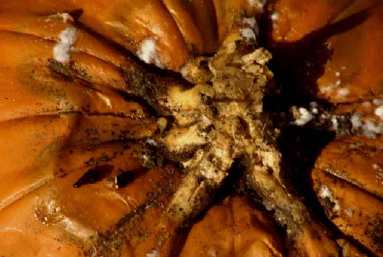
There are 2 critical conditions that determine whether white rot will develop:
- wounding is necessary for the initial development of the disease. Once disease has developed initially, it can spread to other plants or other parts of the same plant by contact
- free moisture must be present for at least 3 days.
Sclerotinia is a weak pathogen and if these 2 conditions are not met, disease will not develop. This fungus is always present in the soil. Crop rotation has no affect on its abundance. However, it has been found to be especially common in the soil around dandelion roots.
Fusarium
This disease results from infested soil. Soil can become infested by planting infected seed. The fungus Fusarium affects plants in 2 ways: either root rot develops and the plant wilts or the fruit becomes infected, resulting in dry rot or breakdown.
There appears to be actually 2 forms of the fungus that cause these 2 different symptoms. In the field, there may be a roughly circular area where breakdown of the fruit occurs. There is no way to treat for this disease. Prevention is the only means of control.
This fungus can be seed-borne. Pay special attention to using disease-free seed. Hot water seed treatment, which kills the fungus, unfortunately also destroys about 1/3 of the seeds as well. If outbreaks of Fusarium have occurred, do not plant pumpkins in that field for 3–4 years.
Downy mildew
This disease is less prevalent than powdery mildew but sometimes can be a problem. Downy mildew grows on the underside of leaves but yellow spots can be seen from the top. Fuzzy growth that is grey to purple is seen on the underside of leaves. The disease affects only leaves and will not transfer to fruit. The biggest problem is that the leaves die prematurely from the fungus. Airborne spores travel both short and long distances, infecting only cucurbits. The disease is controlled with fungicides as with powdery mildew.
Fruit rots
Anthracnose, black rot (Figure 6), phytopthora (Figure 7), soft rot or fusarium rot organisms are often related to wet conditions as fruit ripen — particularly where fruit have contact with the soil. Secondary fruit rots can occur due to wounding of the fruit by cucumber beetles, rodents and otherwise rough handling. Control of fruit rot diseases include: harvesting only fully ripened fruit, practice good crop rotation as many of the rots are soil and debris related, good drainage and water management, and control of cucumber beetles.
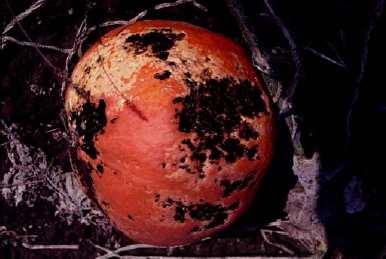
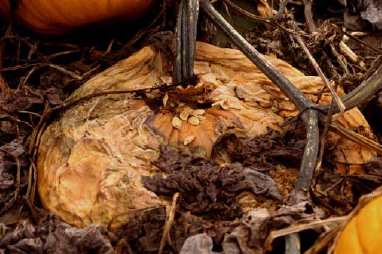
Septoria leafspot
This disease can show up on both the leaves and fruit of pumpkins and winter squash. With the fruit, small raised whitish spots appear, giving a rash-like appearance. Ordinarily, this disease does not cause fruit to rot. This disease is very similar to oedema, which also results in a raised whitish corky spot of similar size. However, oedema is related to weather patterns.
Virus diseases
A number of mosaic viruses infect squash and pumpkins, and it is often hard to differentiate one virus from another visually. Cucumber mosaic, squash mosaic, watermelon mosaic and zucchini mosaic viruses are the most common. Symptoms include mottled, crinkled leaves, warty fruit with yellow or green raised areas and malformed fruit. These viruses are transported mainly by infected seed or insect vectors such as aphids or cucumber beetles, and therefore control measures include controlling insect vectors. Virus-infected plants should be rogued and removed from the field and destroyed. Otherwise, there are no control measures for these crops once infected.
Oedema
Oedema is a physiological disorder of cucurbits and is most frequently found with pumpkins and winter squash that are subjected to undo moisture stress. This is most often associated with uneven availability of moisture when immature fruit are enlarging. On pumpkin rinds the severity may be enough to make the fruit unmarketable. (Figure 8)
The fruit surface is often raised with circular-shaped lesions that are corky or 'crusty' in appearance and may appear irregularly over the entire surface, or be limited to, for example, the shoulder side exposed to direct sunlight. The crusty appearance is similar to the appearance of scab on hard-shelled fruit, except that the oedema lesions never appear crater-like or shrunken.
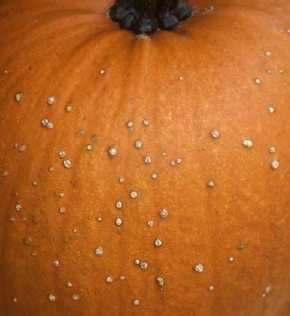
Excessive loss of foliage due to severe powdery mildew can cause plant stress, and oedema-like linear cracks can also develop on the surface. On buttercup squash the corky lesions may be circular, spindle or apostrophe-shaped. On butternut squash, oedema appears as linear growth cracks usually on the neck portion of the fruit.
Insects
Striped cucumber beetle
The most serious insect pest of pumpkins is the striped cucumber beetle. This insect is destructive in all of its life stages and to all parts of the pumpkin and squash (Figure 9). As extensive and damaging as feeding is by these insects, the aspect which makes them such a devastating pest is their ability to spread bacterial wilt (Figure 10).
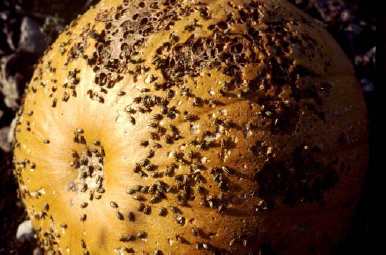
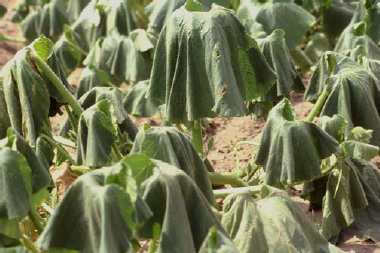
Unmated adult beetles spend the winter in the shelter of fencerows, debris and leaf litter in surrounding wooded areas. These adults emerge from cover early in the spring and can be found on dandelions, wild cucumber and wild plum before vine crops are planted. If they have fed on plants in the fall that were infected with bacterial wilt, the bacteria will pass the winter in the intestines of the beetle, ready to enter vine crops when the beetle begins feeding on them in the spring. There is no control for bacterial wilt. The only way to control this wilt is by controlling the beetle.
These beetles are strongly attracted by the scent of vine crops and will move to fields of cucumber, melons and pumpkins as soon as plantings begin to emerge. Research projects are investigating the possibility of using specially designed scents to attract the beetles in the spring and lure them away from crops. Cucumber beetles must be controlled when they are first noticed in the spring. They will continue to migrate into cucurbit fields over a period of a few weeks. Daily vigilance is essential during the emergence and early life of the crop while the plant is small and susceptible.
After appearing in the spring, the beetles mate, lay eggs near emerging seedlings and continue to feed on young plants while the eggs hatch and larvae damage underground plant parts. As the season progresses, new adults emerge from the soil midsummer and feed on developing vines. If they feed on plants that are infected with bacterial wilt, the bacteria are taken up into the insect's intestines and transferred to other plants during feeding or when the insect leaves droppings.
Cucumber beetles can also cause feeding damage on blossoms, and late-season feeding can occur on mature and maturing fruit.
Cucumber beetles prefer cucumber, muskmelon, winter squash and pumpkin in descending order. However, this is not to say that pumpkins are safe if they are next to a cucumber field.
Squash bug
This greyish-black bug is commonly found on all vine crops but shows a marked preference for pumpkins and squash. (Figure 11) It is slow to emerge in the spring and usually appears about the time the vines begin to run. The adults are shy insects and are usually found sheltered under leaves, clods of dirt or debris. Shortly after the adults are found, there may be small yellowish-brown to brick-red eggs laid on the underside of the leaves.
Damage from this insect results from a toxin that is injected into the plant when the insect feeds. This toxin can cause complete wilting of young plants. In older plants, feeding produces dried, blackened areas where the insect has been sucking. Severe infestations can be treated with insecticides as described in OMAFRA Publication 363. For localized infestations, which are more common, removing the egg masses can be effective.
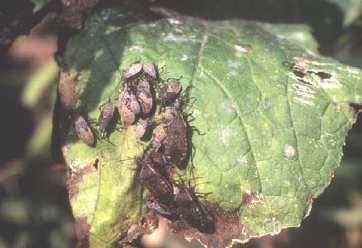
Sanitation is a good preventive strategy. Disk under plant refuse as soon as possible after the crop is harvested and remove any objects, for example — field containers, wagons, or machinery — that will provide the shelter these insects need in order to survive the winter.
Western corn rootworm
This insect is really only a threat when fertilization of the flowers is taking place. The Western corn rootworm eats the pollen in the male flowers, interfering with fertilization. This insect really prefers corn, and remains in the corn silks until they dry up. It prefers cucumbers or squashes over pumpkins. If sweet corn, cucumbers or squash is grown in addition to pumpkins, make sure that these plantings are downwind of the pumpkins. Once the fruit has set, infestations of Western corn rootworm in later flowers will not affect yield.
Squash vine borer
The squash vine borer is a pest on pumpkins, squash, marrow and gourds. The adult is an attractive clear-winged moth with black and orange body and orange legs fringed with long, black hairs. The larva is the destructive stage of this pest as it feeds within the vine and causes the plant to wilt and/or collapse often causing death. Although squash is the preferred host, butternut squash is apparently immune to this pest.
Harvesting
Summer squashes, such as zucchini and patty-pan, are harvested when immature, and used as a fresh vegetable either stewed, boiled or fried. They develop very rapidly after their flowers have opened, and must be harvested before the rind begins to harden. If the thumbnail will not easily puncture the rind, the fruit is too old to be used for fresh-market purposes. Careful handling is important since the young, tender fruits bruise very easily.
Pumpkins and winter squashes are not harvested until they are fully ripe and the skins are hard. They are either pulled or cut from the vine with a portion of the stem attached to the fruit; removal of the stem leaves a wound through which decay organisms may enter. When gathering squashes or pumpkins for storage, handle them carefully to avoid bruising, as damaged fruits soon rot.
Winter squash are only harvested once the fruit are fully mature. At this stage, the skin of the squash is hard and impervious to scratching. Three or four months are required to mature a crop, and the fruit are all generally ready to be picked at one time. Do not leave squash in the field when a hard frost is predicted as this predisposes the fruit to disease-rotting organisms — either in the field or storage.
Curing and storing
Only the hard-shelled squashes are adapted for long-term storage, although pumpkins, properly handled, can be kept until after Christmas. After the fruits are harvested, they should be ripened or cured so they will keep longer and in better condition in storage. Curing hardens the shell, heals superficial wounds, reduces the high water-content of the fruit, and improves the eating quality. The fruits can be cured either by leaving them in small piles in the field for 10 days to 2 weeks when the weather is warm and dry, or by keeping them inside at room temperature for a month. A more reliable method is to use artificial heat at a temperature of 26°C–29°C. (80°–85°F) with a relative humidity of about 80%.
Unlike most other vegetables, squashes and pumpkins require warm, fairly dry storage conditions. After the curing period, carefully place the fruits in a single layer on shelves, leaving a small space between each fruit. Maintain a temperature of 10°C (50°F) and a relative humidity of 70%–75%. Temperatures above 15°C (60°F) promote high respiration and shrinkage. Do not allow the temperature to fall below 5°C (40°F). Cold-storage rooms are not suited to the storage of pumpkins and squashes because the high humidity encourages rot.
Ordinarily, pumpkins do not require curing as the marketing season is relatively short for Halloween or the pie trade.
Yield potential and marketing
Industry expectation
For the Jack-O'lantern trade, yields can be expected to be about 2,500 to 3,000 pumpkins per acre. This will vary somewhat with plant spacing. Keep in mind that only 1.5–2.0 fruit adequately set per plant on average.
The smaller pie pumpkins will yield closer to 5,000 fruit/ac while the mini's should yield 200 bushels. Each bushel holds about 125 fruit.
Most winter squash varieties yield in the range of about 20,000 kg/ha (20,000 lbs/ac).
Yields can vary considerably depending upon what is considered to be marketable — which in turn, is somewhat dependent upon supply and demand.
Harvest season/period
The pie pumpkins and some of the mini pumpkins come on early and harvest can begin during the first part of August. However, the main Jack-O-lantern types tend not to ripen until late August, September and into October. Those varieties with the precocious gene will ripen considerably earlier than those varieties without.
Winter squash varieties are usually harvested during the months of September and October. Some of the earlier maturing varieties such as the acorn type are mature in August. Although late harvests of winter squash may run into November, cool wet weather, and heavy frosts may discolour fruit, or in more severe cases cause fruit breakdown.
Main methods of merchandising
About half of the market for pumpkins is probably sold roadside while the other is sold by the trailer load made up of cardboard bins. About 30–40 bins would represent 1 acre with each bin holding on average 40–45 pumpkins with a greater range of 30–60 pumpkins each depending upon size. Bins can weigh up to 800–900 lbs.
Winter squash is sold wholesale by bushel basket or cardboard bins.